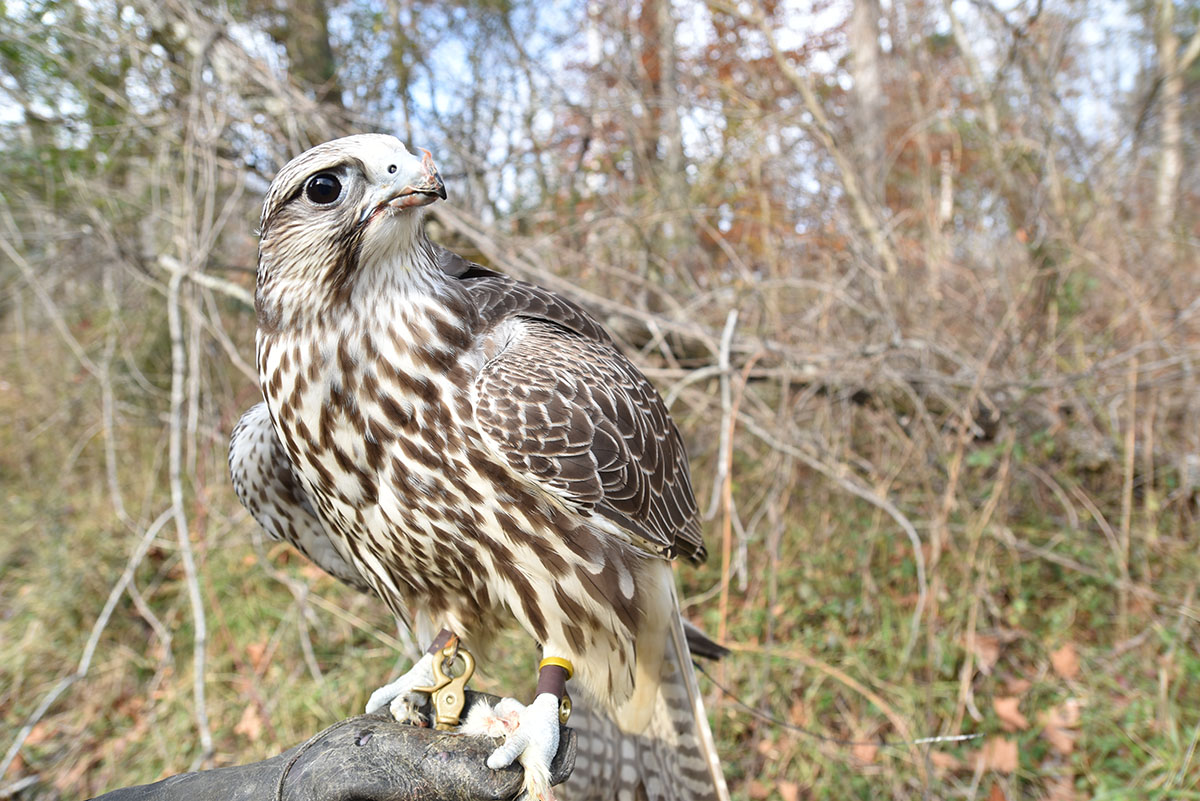
Corey Basham and his gyrfalcon, Gucci.
By Bruce Ingram
Photos by Bruce Ingram
When I first met Corey Basham, he was administering to a raptor near the banks of the James River. I assumed that the gyrfalcon had been injured in some way, but, in truth, Basham, who works for the Virginia Department of Health in Goochland County, and his bird Gucci were teaming up to hopefully accomplish what both of them desired—a duck dinner.
Falconry, the activity of using birds of prey to hunt game, may have begun as long as 8,000 to 10,000 years ago. Basham, who has practiced the pastime for 10 years, explains what drew him to the time-honored activity.
“Just like some anglers go from bait fishermen to fly fishermen for the challenge, I went from a gun hunter to becoming a falconer,” he says. “Most falconers in Virginia use red-tailed hawks to hunt squirrels and rabbits, but I wanted a change of pace and the ability to hunt ducks regularly, so that’s why I went with the larger gyrfalcon.” The gyrfalcon is migratory species in Virginia, not a nesting species, and less commonly seen.

Gucci the gyrfalcon.
Basham emphasizes that training Gucci was difficult but enjoyable.
“Falcons as a whole are a little touchy,” he explains. “Training moves slower than it does with red-tailed hawks. Both raptors hunt differently, too. Red-tails are ambush hunters most days, waiting for their prey to come where they are perched. A gyrfalcon is a seeker predator, staying on the wing and looking across the landscape for prey.
“Another really enjoyable thing about hunting with a falcon is their stoop, or drop, when they go into pursuit mode. A peregrine falcon can reach 240 mph on their stoop. Gyrfalcons don’t quite go that fast, but they can achieve speeds over 100 mph. And they can fly both over and under a duck to grab it with their feet and talons.”
Falconers can trap the raptors they want to employ in hunting, but since gyrfalcons rarely appear naturally in Virginia, Basham had to buy Gucci from an upstate New York breeder in April of 2021. Training the young bird began as soon as they arrived home.
“At first I kept a leather hood on her head as a calming mechanism, gradually letting in more light as Gucci got to know me,” Basham says. “I would also give her meat while holding her on the fist so she would come to regard me as a food source.”
Next came flight training as the gyrfalcon learned to fly out from her owner and return to the glove—with a reward of meat from Basham. Finally came actual hunts. During the first few successful outings when Gucci downed waterfowl, she was allowed to eat as much as she desired from the carcass. Throughout this entire process, Basham always weighed the falcon to make sure she was maintaining her appetite so that she would respond when the opportunity to catch game arose.
“The key for a bird becoming a successful hunter is it realizing that it gets to keep the prey that it captures,” Basham says. “When Gucci brings down a duck, she eats her fill, and the leftovers go home with me. She’s equipped with a tracking device, so I can tell when she’s successful and on the ground or has decided to fly further away than I like.”
Among the requirements to become a falconer, Basham says individuals must be at least 12 years old, pass a multiple choice test, and find a sponsor who will mentor them as apprentices for two years. He adds that this will be the first year that he will serve as a mentor.
More information can be found at https://dwr.virginia.gov/forms-download/PERM/falconry.pdf
Read more about falconry in the article “Falconry Gives a Front Row View of Nature at Work” from the January/February 2022 issue of Virginia Wildlife magazine.

